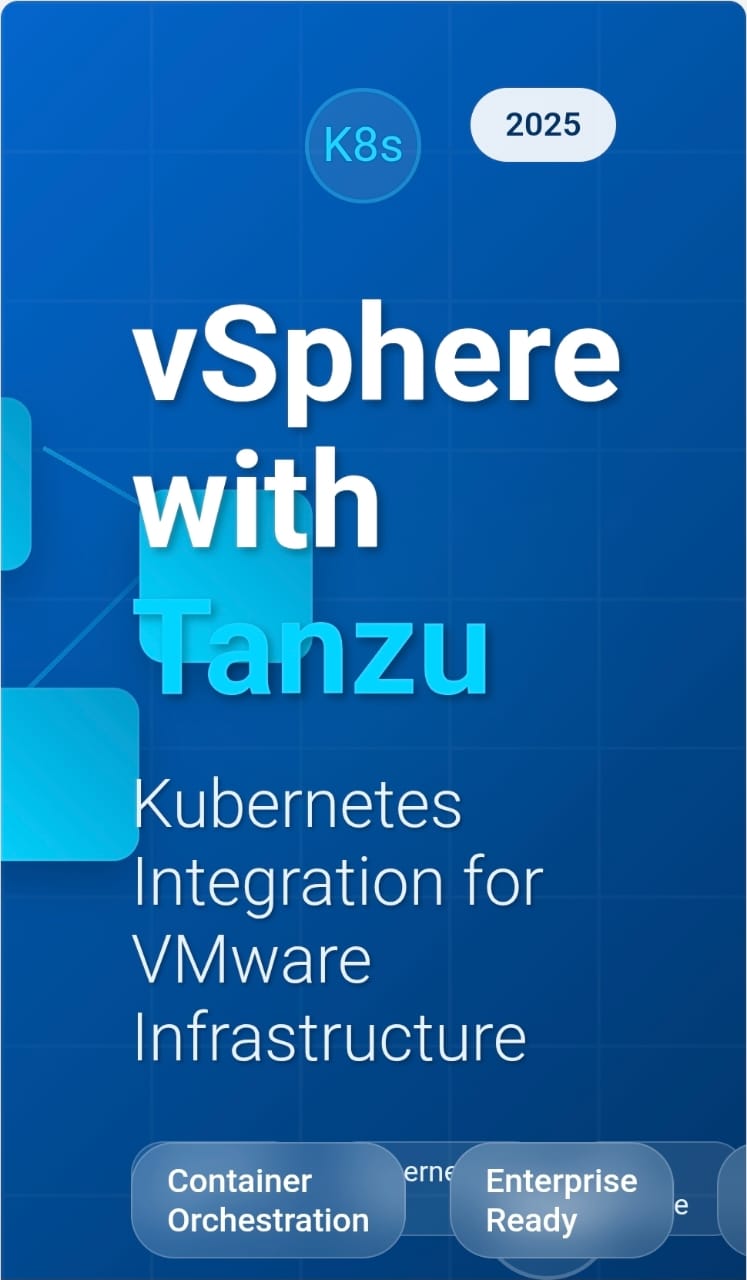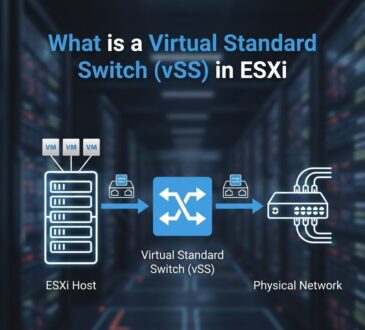
Table of Contents
What is vSphere with Tanzu? The Enterprise Kubernetes Evolution
vSphere with Tanzu represents VMware’s ambitious vision of bringing Kubernetes directly into the vSphere ecosystem. Think of it as the marriage between your trusted virtualization platform and the container orchestration powerhouse that’s driving modern application development.
At its core, vSphere with Tanzu transforms your existing vSphere infrastructure into a unified platform capable of running both traditional virtual machines and modern Kubernetes workloads side by side. This isn’t just another Kubernetes distribution – it’s a fundamental reimagining of how enterprise infrastructure should work.
The Architecture That Changes Everything
The magic happens through what VMware calls the Supervisor Cluster – a specialized layer that runs directly on your ESXi hosts. This architectural breakthrough eliminates the complexity of managing separate Kubernetes infrastructure while providing enterprise-grade features like:
- Native vSphere integration with existing storage, networking, and security policies
- Workload isolation through vSphere namespaces
- Multi-tenancy support for different teams and projects
- Unified management through the familiar vCenter interface
Why vSphere with Tanzu is a Game-Changer for Enterprise IT
1. Simplified Kubernetes Deployment and Management
Remember the days when deploying Kubernetes meant weeks of planning, complex networking configurations, and endless troubleshooting? vSphere Kubernetes release 1.32 brings greater efficiency, security, and flexibility to your workloads, making deployment as straightforward as provisioning a virtual machine.
The platform eliminates the traditional barriers to Kubernetes adoption:
Zero-touch Cluster Provisioning Through vCenter: Gone are the days of manual cluster setup and configuration. vSphere with Tanzu provides a streamlined deployment process through the familiar vCenter interface. Administrators can provision new Kubernetes clusters with just a few clicks, eliminating the complexity of manual installations. The platform automatically handles node bootstrapping, networking configuration, and security certificate management, reducing deployment time from weeks to minutes.
Automatic Lifecycle Management for Kubernetes Versions: Keeping Kubernetes clusters up-to-date has traditionally been a major operational burden. vSphere with Tanzu automates this process by providing centralized lifecycle management capabilities. The platform automatically tracks available updates, provides upgrade recommendations, and can perform rolling updates with minimal downtime. This automation ensures that clusters remain secure and up-to-date without requiring extensive manual intervention.
Seamless Integration with Existing vSphere Tools and Processes: Organizations don’t need to abandon their existing operational procedures when adopting Kubernetes. vSphere with Tanzu integrates directly with established vSphere workflows, including backup solutions, monitoring tools, and change management processes. This integration means that existing operational teams can leverage their current expertise while gradually building Kubernetes knowledge.
Consistent Experience Across Development, Testing, and Production Environments: One of the biggest challenges in Kubernetes adoption is maintaining consistency across different environments. vSphere with Tanzu provides a unified platform that ensures identical configurations and behaviors from development through production. This consistency eliminates the “it works on my machine” problem and reduces deployment risks.
2. Enterprise-Grade Security and Compliance
Security isn’t an afterthought in vSphere with Tanzu – it’s baked into the foundation. The platform provides:
FIPS Compliance Capabilities: For organizations with strict security requirements, FIPS compliance is critical for meeting security requirements and reducing compliance risks. vSphere with Tanzu provides built-in FIPS 140-2 compliance capabilities, making it an ideal choice for government, financial, and healthcare organizations. The platform ensures that all cryptographic operations meet federal standards, providing the security assurance required for sensitive workloads.
Network Micro-segmentation Through NSX Integration: Traditional network security relies on perimeter-based protection, which is insufficient for modern microservices architectures. vSphere with Tanzu integrates with NSX-T to provide micro-segmentation capabilities that create security boundaries around individual workloads. This approach ensures that compromised containers cannot laterally move through the network, significantly reducing attack surfaces.
Identity and Access Management Integration with vCenter SSO: Managing user access across multiple systems creates security gaps and administrative overhead. vSphere with Tanzu leverages vCenter’s Single Sign-On (SSO) infrastructure to provide unified authentication and authorization. This integration ensures that existing identity policies and access controls extend seamlessly to Kubernetes environments, maintaining security consistency across the entire infrastructure.
Encrypted Communications Between All Cluster Components: Data in transit is protected through comprehensive encryption that covers all communication channels within the platform. This includes API server communications, etcd cluster traffic, and inter-node communications. The encryption is implemented using industry-standard TLS protocols with regularly rotated certificates, ensuring that sensitive data remains protected even if network traffic is intercepted.
3. Operational Efficiency That Transforms Teams
The operational benefits of vSphere with Tanzu extend far beyond simple deployment. Centralizing the control of multiple Kubernetes clusters with Tanzu Standard increased operational efficiency by 91%. This dramatic improvement comes from:
Unified Monitoring and Alerting Across VM and Container Workloads: Traditional environments require separate monitoring solutions for virtual machines and containers, creating operational silos and increasing complexity. vSphere with Tanzu provides integrated monitoring that spans both VM and container workloads through a single interface. This unified approach enables operations teams to correlate events across different infrastructure layers, reducing mean time to resolution for incidents.
Consistent Backup and Disaster Recovery Strategies: Data protection strategies often break down when organizations adopt containerized workloads because traditional backup solutions don’t understand Kubernetes constructs. vSphere with Tanzu extends existing vSphere backup and disaster recovery capabilities to include Kubernetes workloads. This integration ensures that containerized applications receive the same level of protection as traditional VMs, using familiar tools and processes.
Centralized Policy Enforcement for Governance and Compliance: Maintaining consistent policies across multiple Kubernetes clusters is a significant challenge for enterprise organizations. vSphere with Tanzu provides centralized policy management that ensures governance requirements are enforced consistently across all environments. These policies can cover resource quotas, security controls, and compliance requirements, providing automated enforcement that reduces risk and administrative overhead.
Reduced Learning Curve for Existing vSphere Administrators: The transition to Kubernetes often requires organizations to hire new talent or extensively retrain existing staff. vSphere with Tanzu minimizes this challenge by providing a familiar management interface that extends existing vSphere concepts to Kubernetes. Administrators can leverage their existing knowledge while gradually building container expertise, reducing training costs and time-to-competency.
Key Features That Set vSphere with Tanzu Apart
Kubernetes Namespaces with vSphere Superpowers
vSphere with Tanzu introduces the concept of vSphere Namespaces – logical boundaries that provide resource isolation and governance. Each namespace can have:
Resource Quotas and Limits for CPU, Memory, and Storage: vSphere Namespaces provide granular resource management that goes beyond basic Kubernetes capabilities. Administrators can set precise limits on CPU cores, memory allocation, and storage consumption for each namespace. These quotas prevent resource contention and ensure fair resource distribution across different teams and projects. The system enforces these limits in real-time, preventing any single namespace from consuming excessive resources and impacting other workloads.
Access Controls for Different User Groups and Service Accounts: Enterprise organizations require sophisticated access control mechanisms that align with their security policies and organizational structure. vSphere Namespaces integrate with vCenter’s role-based access control (RBAC) system, allowing administrators to define granular permissions for different user groups. This integration ensures that developers can only access resources within their assigned namespaces while maintaining the security boundaries required for multi-tenant environments.
Network Policies for Secure Communication Between Workloads: Network security in Kubernetes environments requires careful consideration of communication patterns and security requirements. vSphere Namespaces support advanced network policies that control traffic flow between different workloads and namespaces. These policies can implement micro-segmentation strategies, ensuring that sensitive workloads remain isolated from less trusted components. The policies are enforced at the network level, providing defense-in-depth security.Storage Policies That Automatically Provision Appropriate Storage Classes: Storage management in Kubernetes can be complex, especially when dealing with different performance and availability requirements. vSphere Namespaces automatically apply appropriate storage policies based on workload requirements and organizational standards. These policies ensure that applications receive the correct storage characteristics without requiring detailed storage expertise from development teams. The automation reduces configuration errors and ensures consistent storage behavior across environments.
Complete Installation Guide: vSphere with Tanzu Step-by-Step
Prerequisites and Requirements
Before beginning the installation, ensure your environment meets these critical requirements:
Hardware Requirements
A minimum of 3 ESXi hosts in a vSphere cluster is required, as the vSphere with Tanzu control plane consists of 3 nodes for high availability. Each ESXi host should have:
- CPU: Minimum 4 cores per host, 8 cores recommended for production
- Memory: 32GB minimum per host, 64GB recommended for production workloads
- Storage: vSAN or shared storage with sufficient capacity for VM and container workloads
- Network: Multiple network adapters for management and workload traffic separation
Software Requirements
vCenter Server and ESXi must be version 7.0 Update 2 or later when using NSX, or version 7.0 Update 1 or later for vSphere Distributed Switch environments:
- vCenter Server: 7.0 U2+ (with NSX) or 7.0 U1+ (without NSX)
- ESXi: 7.0 U2+ (with NSX) or 7.0 U1+ (without NSX)
- NSX-T: 3.0 or later (if using NSX networking)
- vSphere Distributed Switch: 7.0 or later (if not using NSX)
Network Architecture Planning
You will need two separate routable subnets configured at a minimum with three preferred. One subnet will be for Management Networking (ESXi, vCenter, the Supervisor Cluster, and load balancer). The second subnet will be used for Workload Networking (virtual IPs and TKG cluster):
Management Network Requirements:
- Subnet for ESXi hosts, vCenter Server, and Supervisor Cluster nodes
- Load balancer IP addresses for the HAProxy appliance
- DNS and NTP services accessible from this network
- Internet access for container image downloads (or internal registry)
Workload Network Requirements:
- Separate subnet for Kubernetes cluster nodes and services
- IP pool for dynamic allocation to workloads
- Ensure that the Workload network and the FrontEnd network are routable to each other
- Ingress and egress connectivity for application traffic
Step-by-Step Installation Process
Step 1: Environment Preparation
1.1 Validate Infrastructure Begin by verifying that your vSphere environment meets all prerequisites:
# Check vCenter and ESXi versions
Get-VMHost | Select Name, Version, Build
Get-VIObjectByVIView (Get-View -ViewType ServiceInstance).Content.About | Select Name, Version, Build
1.2 Configure vSphere Distributed Switch vSphere Distributed Switch (VDS) configured for all hosts in the cluster is essential:
- Create a vSphere Distributed Switch with appropriate port groups
- Configure VLAN tagging for network segmentation
- Ensure all ESXi hosts are connected to the distributed switch
- Verify network connectivity between management and workload networks
1.3 Storage Configuration Prepare storage for both traditional VMs and persistent volumes:
- Configure vSAN or shared storage with sufficient capacity
- Create storage policies for different workload types
- Ensure storage is accessible from all ESXi hosts in the cluster
- Plan for persistent volume requirements and growth
Step 2: Workload Management Configuration
2.1 Access Workload Management Open Workload Management from the vSphere Client and click on Get Started:
- Navigate to the vSphere Client
- Select Workload Management from the main menu
- Click Get Started to begin the configuration wizard
2.2 Select Management Components Select vCenter Server and NSX from the options and click Next:
- Choose your vCenter Server instance
- Select NSX-T manager if using NSX networking
- Alternatively, select vSphere Distributed Switch for simpler networking
- Verify connectivity between selected components
2.3 Choose Compatible Cluster Select the Compatible Cluster where you plan to enable Tanzu:
- Choose a cluster with at least 3 ESXi hosts
- Ensure the cluster has sufficient resources for the Supervisor Cluster
- Verify that all hosts meet the minimum requirements
- Confirm storage and network connectivity
Step 3: Network Configuration
3.1 Management Network Setup Configure the network settings for the Supervisor Cluster:
- Management Network: Select the port group for management traffic
- DNS Servers: Configure primary and secondary DNS servers
- NTP Servers: Set up time synchronization servers
- Search Domain: Define the DNS search domain for the environment
3.2 Workload Network Configuration Choose a Workload Network and assign it an IP. Once that is done, power it on and you are ready to enable vSphere with Tanzu:
- Workload Network: Select the port group for Kubernetes workloads
- IP Address Pool: Define the IP range for dynamic allocation
- Subnet Mask: Configure appropriate subnet masking
- Gateway: Set the default gateway for workload traffic
3.3 Load Balancer Configuration If using HAProxy as the load balancer:
- Load Balancer Image: Select the HAProxy OVA image
- Management IP: Assign an IP address for HAProxy management
- Workload IP Range: Define the IP pool for load balancer services
- Server Certificate: Configure SSL certificates for secure communication
Step 4: Storage Policy Assignment
4.1 Create Storage Policies Define storage policies for different workload types:
# Example storage policy for high-performance workloads
apiVersion: storage.k8s.io/v1
kind: StorageClass
metadata:
name: vsan-ssd-policy
provisioner: csi.vsphere.vmware.com
parameters:
storagepolicyname: "vSAN-SSD-Policy"
csi.storage.k8s.io/fstype: "ext4"4.2 Assign Default Storage
- Select the default storage policy for the Supervisor Cluster
- Configure storage classes for different performance requirements
- Ensure adequate capacity for control plane and workload storage
Step 5: Supervisor Cluster Deployment
5.1 Review Configuration Before deployment, review all configuration settings:
- Network configuration and IP allocations
- Storage policies and capacity planning
- Resource allocation for control plane nodes
- DNS and certificate configuration
5.2 Deploy Supervisor Cluster Initiate the deployment process:
- Click Finish to start the deployment
- Monitor the deployment progress in the vSphere Client
- Verify that all three control plane nodes are created successfully
- Ensure network connectivity and storage attachment
5.3 Post-Deployment Verification After deployment completes:
# Verify Supervisor Cluster status
kubectl get nodes --server=https://supervisor-cluster-ip:443
# Check system pods
kubectl get pods --all-namespaces --server=https://supervisor-cluster-ip:443Step 6: Namespace Creation and Configuration
6.1 Create vSphere Namespaces Set up namespaces for different teams or projects:
- Navigate to Workload Management > Namespaces
- Click Create Namespace
- Define namespace name and description
- Assign resource quotas and limits
- Configure permissions and access controls
6.2 Configure Resource Quotas Set appropriate resource limits for each namespace:
# Example resource quota configuration
apiVersion: v1
kind: ResourceQuota
metadata:
name: compute-quota
namespace: dev-namespace
spec:
hard:
requests.cpu: "10"
requests.memory: 20Gi
limits.cpu: "20"
limits.memory: 40Gi
persistentvolumeclaims: "10"6.3 Set Up User Access Configure authentication and authorization:
- Integrate with vCenter SSO for user authentication
- Assign appropriate roles and permissions
- Configure RBAC policies for namespace access
- Set up service accounts for automated deployments
Installation Troubleshooting and Validation
Common Installation Issues
Network Connectivity Problems:
- Verify routing between management and workload networks
- Check DNS resolution for all components
- Ensure firewall rules allow required traffic
- Validate load balancer IP allocation and accessibility
Storage Configuration Issues:
- Confirm storage policy compatibility with vSAN or shared storage
- Verify adequate capacity for control plane and workloads
- Check storage accessibility from all ESXi hosts
- Validate persistent volume claim creation
Resource Allocation Problems:
- Ensure sufficient CPU and memory resources on ESXi hosts
- Verify cluster resource pools and limits
- Check for resource contention with existing workloads
- Validate HA and DRS configuration
Installation Validation Steps
1. Control Plane Health Check:
# Check control plane node status
kubectl get nodes --server=https://supervisor-cluster-ip:443
# Verify system services
kubectl get pods -n kube-system --server=https://supervisor-cluster-ip:4432. Network Connectivity Test:
# Test pod-to-pod communication
kubectl run test-pod --image=busybox --command -- sleep 3600
kubectl exec test-pod -- ping <target-ip>3. Storage Functionality Test:
kubectl apply -f - <<EOF
apiVersion: v1
kind: PersistentVolumeClaim
metadata:
name: test-pvc
spec:
accessModes:
- ReadWriteOnce
resources:
requests:
storage: 1Gi
EOF
Final Thoughts
If you’re considering vSphere with Tanzu for your organization, remember that success isn’t just about technology – it’s about transformation. The platform provides the technical foundation, but your organization’s success will depend on:
- Clear vision for how Kubernetes fits into your strategy
- Strong executive support for the transformation initiative
- Dedicated resources for implementation and operations
- Commitment to continuous learning and improvement
The journey to modern, containerized infrastructure doesn’t have to be overwhelming. With vSphere with Tanzu, you’re not just adopting Kubernetes you’re embracing a platform that respects your existing investments while enabling future innovation.
- Design






